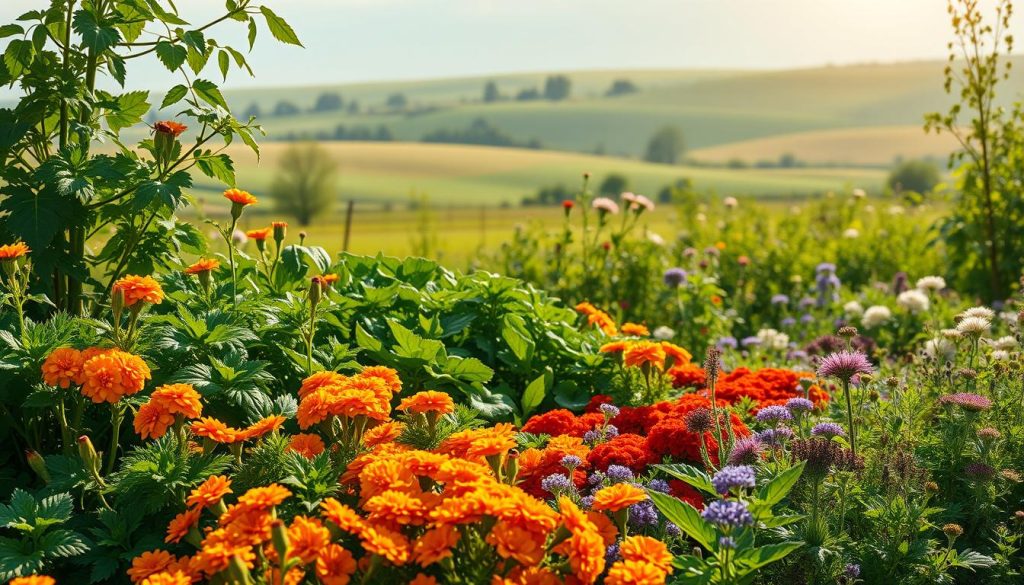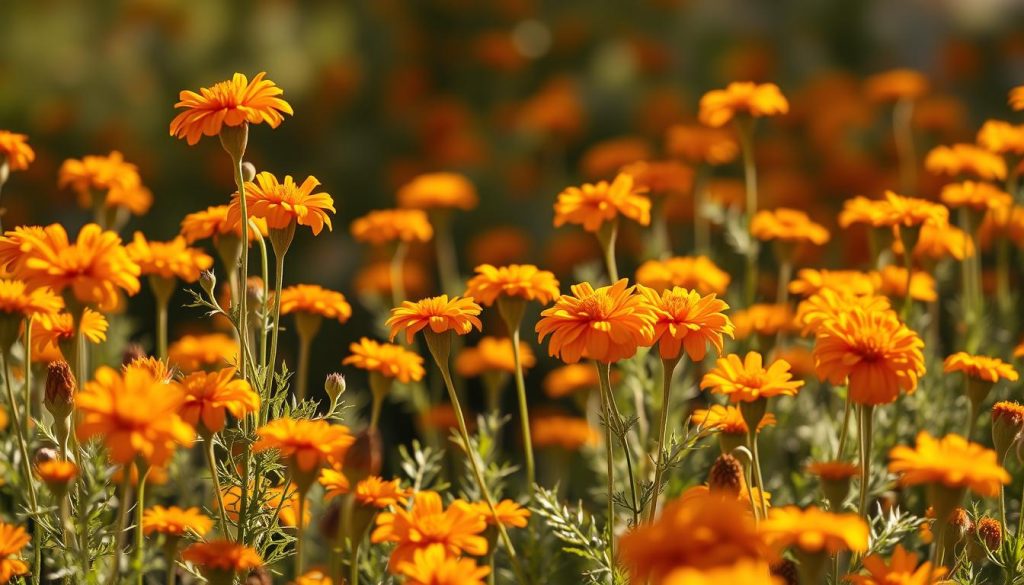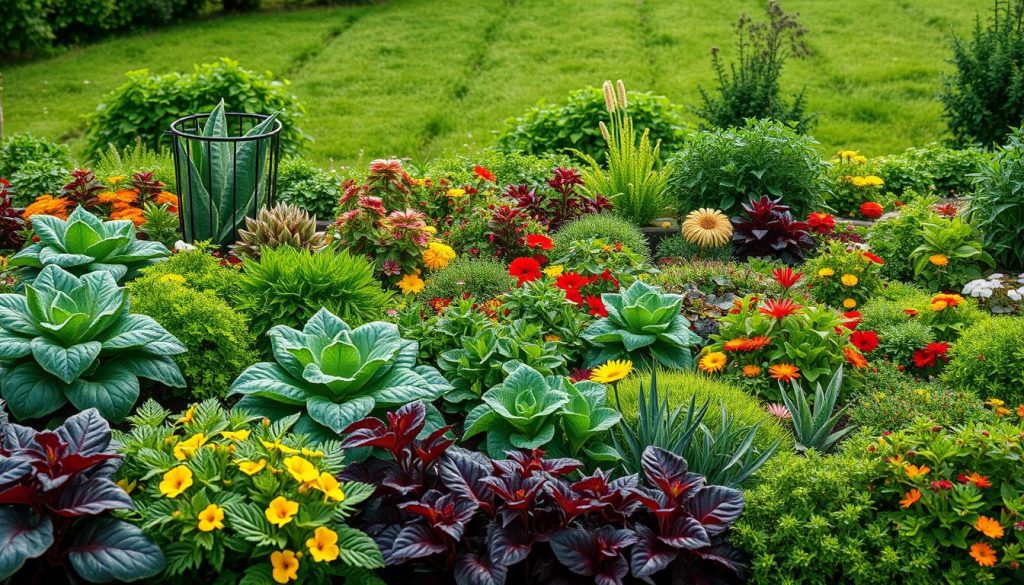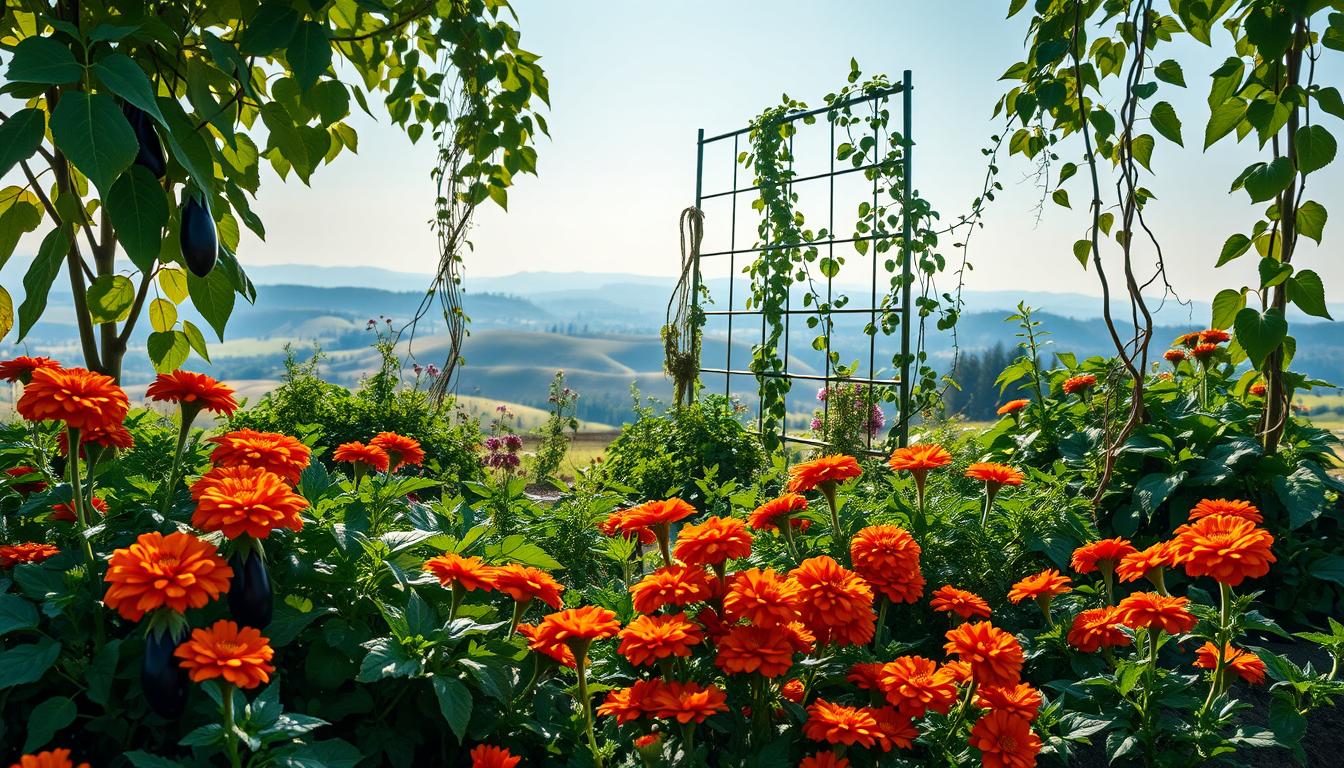Gardeners have known for centuries that some plants grow better together. This natural way of gardening brings harmony to your garden beds. It’s like having good neighbors who help each other thrive.
The practice of companion planting goes back to indigenous cultures worldwide. Now, science backs up what traditional gardeners always knew. By pairing the right plants, you can naturally keep pests away, increase harvests, and create a diverse ecosystem.
Think of your garden as a community, not just a collection of plants. Working with nature’s patterns means using fewer chemicals and getting better results. This approach is simple and accessible to everyone.
Ready to find out which plants are the best garden friends? Let’s see how these natural relationships can make your garden a thriving, productive haven.
The Ancient Wisdom of Plant Partnerships
Companion planting has been around for thousands of years. Farmers worldwide noticed how some plants helped each other. This wisdom was shared across continents, showing similar patterns.
Indigenous communities, Asian farmers, and European gardeners all used plant combinations. They didn’t know the science behind it but saw the benefits. Their knowledge was passed down through generations.
These early farmers developed sophisticated systems. They didn’t rely on myths but on practical experience. Their methods led to better harvests, fewer pests, and healthier soil.
Historical Practices Across Cultures
The “Three Sisters” method in Native American agriculture is well-known. Corn, beans, and squash worked together. Corn supported beans, beans fixed nitrogen, and squash kept weeds away.
In Asia, rice paddies included fish and ducks. These animals controlled pests and added fertilizer. This showed a deep understanding of ecosystems.
European cottage gardens combined vegetables, herbs, and flowers. Aromatic herbs like rosemary and thyme kept pests away. Flowers attracted helpful pollinators.
From Traditional Knowledge to Modern Science
The 20th century marked a shift from folk wisdom to science. Researchers documented the reasons behind companion planting’s success. They confirmed what traditional farmers knew.
Modern studies have shown many benefits of intercropping. These include better resource use, pest control, and biodiversity. Scientists now know plants communicate through chemicals, forming complex relationships.
Today, there’s a renewed interest in polyculture. As conventional farming faces sustainability challenges, these ancient methods offer solutions. They connect traditional knowledge with modern science.
What Makes Companion Planting So Effective
Companion planting works because of how plants interact with each other and their surroundings. By choosing the right plants to grow together, we create a balanced garden ecosystem. These pairings are based on patterns that gardeners and scientists have studied.
Plants can help or harm each other in different ways. The best garden plans use these interactions to their advantage. By mimicking nature, our gardens become more productive and need less outside help.

The Core Principles of Plant Synergy
Companion planting is based on a few key principles. One is resource partitioning, where plants use different parts of the soil. For instance, deep-rooted plants can bring up nutrients for their shallow-rooted friends.
Another principle is physical support. Tall plants can act as trellises for climbing plants. A classic example is corn and bean vines, where the beans fix nitrogen for the corn.
Guild planting takes these ideas further. It involves creating groups of plants that work together. These groups include nitrogen fixers, dynamic accumulators, insectary plants, and groundcovers. Each type of plant has a specific role to play.
| Guild Component | Function | Example Plants | Benefits |
|---|---|---|---|
| Nitrogen Fixers | Enrich soil | Beans, peas, clover | Reduce fertilizer needs |
| Dynamic Accumulators | Mine nutrients | Comfrey, dandelion | Bring up deep minerals |
| Insectary Plants | Attract beneficials | Dill, fennel, marigolds | Natural pest control |
| Groundcovers | Protect soil | Thyme, oregano, strawberries | Reduce weeds, retain moisture |
Beyond Folklore: Scientific Evidence
Modern research is backing up many traditional gardening practices. Scientists have found several reasons why certain plants do well together.
Studies show that some plant combinations can cut pest problems by half. For example, basil can hide the scent of tomatoes from pests, as found in the Journal of Chemical Ecology.
Research also supports the idea that companion planting improves soil health. A study found that growing legumes with vegetables boosted soil nitrogen and microbial activity. This led to 15-25% more yields than single-crop gardens.
Allelopathy, or how plants affect each other with chemicals, is also supported by science. Some plants release substances that help or hinder their neighbors. This chemical communication is key to many successful pairings.
The Science Behind Plant Relationships
Companion planting is more than just a myth. It’s based on real science that shows how plants work together. By learning about these processes, we can pick the best plants to grow together. This creates a strong garden ecosystem.
Chemical Interactions in the Soil
Underground, your garden is full of chemical talks and trades. Plants don’t just sit there; they talk to each other through complex chemical signals.
Root Exudates and Nutrient Exchange
Plant roots send out chemicals that change the soil around them. These chemicals can help or hurt nearby plants. Some chemicals stop other plants from growing, while others help them grow.
For example, beans and peas team up with nitrogen-fixing bacteria. These bacteria turn air into food for plants, helping both the plants and the soil.
The soil is home to billions of tiny helpers like bacteria and fungi. These tiny helpers connect plants, sharing nutrients and warning them about pests.
These networks can cover whole gardens, helping plants share resources. Some plants even help fight off diseases, protecting their neighbors.
Above-Ground Plant Communication
But plants don’t just talk underground. They also communicate above ground, affecting growth and health.
Volatile Compounds and Pest Deterrence
Many plants release chemicals in the air that keep pests away. Marigolds keep nematodes at bay, while basil confuses tomato hornworms. This makes it harder for them to find tomatoes.
Some plants attract good bugs instead of keeping bad ones away. Dill and fennel, for example, attract wasps that eat pests that harm vegetables.
Physical Protection and Microclimate Creation
Plant structure also helps. Corn stalks support beans, and some herbs create humid spots that help other plants. This makes the garden better for everyone.
By choosing the right plants, we can change the light and shade in our gardens. This helps plants that don’t like the sun or heat. It also saves water during hot times.
Knowing how plants work together changes how we garden. It lets us grow strong, healthy gardens with less work and fewer chemicals.
Key Benefits of Companion Planting
Companion planting is a smart way for gardeners to get great results. It creates a self-managing garden ecosystem. This system boosts garden health and productivity without needing chemicals.

Natural Pest Management Without Chemicals
Companion planting is great for keeping pests away naturally. It sets up a defense system that works all the time to protect your garden.
Some plants repel pests with their smells or chemicals. For example, marigolds keep nematodes away. Herbs like basil and rosemary confuse pests.
Other plants attract good bugs that eat pests. These include:
- Ladybugs that eat aphids
- Parasitic wasps that target caterpillars
- Hoverflies whose larvae eat soft-bodied pests
- Ground beetles that hunt slugs and other pests
Improved Pollination and Biodiversity
Companion planting boosts pollination by attracting many beneficial insects. Flowering plants among vegetables create a pollinator paradise. This leads to better fruit and seed production.
More diverse plants support a wider range of beneficial organisms. This makes your garden more resilient to diseases and pests.
Even in small spaces, companion planting mimics natural ecosystems. A diverse garden with different plants provides resources for pollinators all season. This ensures your vegetables get the best pollination.
Enhanced Growth and Yields
Companion plants also help each other grow and produce more. They meet each other’s nutrient needs without competing. This maximizes soil resources.
Some plants support each other physically, like corn for beans. Others create better growing conditions by offering shade or protecting from wind. This helps plants grow stronger and healthier.
The most interesting part is the underground connections between plants. Their roots work together to stimulate growth and improve soil. This results in bigger harvests and healthier plants, all without synthetic fertilizers.
Classic Companion Planting Combinations That Work
Some plant pairings are legendary for their benefits. These combinations show how strategic planting can make a garden thrive. They help plants grow better, keep pests away, and taste better without chemicals.
Good companion planting is more than just putting plants together. It’s about knowing how they work together. Some plants share resources, while others protect their neighbors. Let’s look at some top plant pairs that gardeners have used for years.
The Three Sisters: Corn, Beans, and Squash
The Three Sisters method is a famous technique from Native American farmers. It combines corn, beans, and squash in a way that uses space well.
Beans climb up corn stalks, fixing nitrogen in the soil. Squash spreads out, shading the soil and keeping it moist. Its stems also keep pests away from the corn.
To start the Three Sisters, plant corn when it’s 60°F outside. When corn is 6 inches tall, plant beans around it. A week later, add squash seeds in between the corn. This lets each plant grow well.
Tomato Companions and Antagonists
Tomatoes do well with the right neighbors but struggle with the wrong ones. Knowing these relationships can help your tomatoes grow better and keep your garden healthy.
Marigolds and nasturtiums help tomatoes by keeping pests away. Carrots loosen the soil for tomato roots. Asparagus and tomatoes also protect each other from pests.
Basil and Tomatoes: The Perfect Pair
Basil and tomatoes are a great example of companion planting. Basil makes tomatoes grow better and taste sweeter. It also keeps pests like hornworms and flies away.
Plant basil 10-12 inches from tomatoes. This lets both plants grow well and keeps pests away. It also makes it easy to use both in your cooking.
Plants to Keep Away from Tomatoes
Not all plants are good neighbors for tomatoes. Brassica family plants like cabbage and broccoli take nutrients from tomatoes. Corn and tomatoes also share pests, making them bad companions.
Never plant tomatoes near potatoes. They can spread diseases to each other. Fennel also harms tomato growth, so keep it away.
Herb and Vegetable Partnerships
Herbs are great companions in the garden. They protect plants and make them grow better. Their smells often keep pests away and attract good bugs.
Rosemary keeps carrot flies away, while dill attracts wasps that eat caterpillars. Chamomile makes onions taste better and grow stronger. Sage keeps cabbage moths away, and chives stop aphids on many vegetables.
The table below shows some of the best herb and vegetable pairs for your garden:
| Herb | Vegetable Companion | Benefits | Planting Distance |
|---|---|---|---|
| Rosemary | Carrots, Cabbage, Beans | Repels carrot flies and cabbage moths | 12-18 inches |
| Mint | Cabbage, Tomatoes | Deters cabbage moths and ants | 24 inches (use containers to prevent spreading) |
| Cilantro | Spinach, Lettuce, Peas | Attracts beneficial insects, improves growth | 8-10 inches |
| Thyme | Strawberries, Cabbage, Eggplant | Repels cabbage worms and whiteflies | 10-12 inches |
| Oregano | Peppers, Broccoli, Cauliflower | General pest deterrent, improves flavor | 12-15 inches |
When using these pairs, think about how big each plant will get. Make sure they get enough sunlight and water. This way, each plant can help the others and grow well.
Plants That Repel Garden Pests Naturally
Many plants have built-in defenses against pests. These plants can help gardeners avoid using harmful chemicals. By placing certain plants strategically, you can create a barrier that keeps pests away.
Plants repel pests in different ways. Some have strong smells that mask the scent of other plants. Others release chemicals that directly repel insects. And some have physical traits that pests find unappealing.
Using these plants can also improve your garden in other ways. They can make the soil healthier, attract beneficial insects, and even taste better. This makes natural pest control a smart and sustainable choice.
Aromatic Herbs as Insect Deterrents
Aromatic herbs are key in fighting pests. Their strong smells confuse pests, making it hard for them to find their usual food. This is because many insects rely on smell to find their next meal.
Rosemary and sage keep away pests like cabbage moths and carrot flies. Mint is great at keeping ants and aphids away. It’s best to keep mint in pots to prevent it from taking over.
Lavender is not only beautiful but also keeps moths and mosquitoes away. Basil is great with tomatoes, repelling pests and improving flavor.
Marigolds: The Multi-Purpose Pest Fighter
Marigolds are a standout in pest control. They have strong smells that confuse pests and keep them away. Their roots also fight harmful nematodes in the soil.

Marigolds can be tilled into the soil to reduce nematodes. This is great for protecting plants like tomatoes and strawberries. French and African marigolds both help, but French ones are better at fighting nematodes.
Garlic, Onions, and Chives for Pest Control
The allium family, including garlic, onions, and chives, repels pests with their sulfur compounds. These compounds also help prevent fungal diseases. This makes them a double threat in the garden.
Garlic is very effective against aphids and other pests. It can also protect fruit trees from borers. Onions and chives repel pests like aphids and carrot flies.
Flowers That Attract Beneficial Insects
Attracting beneficial insects is just as important as repelling pests. These insects help control pest populations naturally. Creating a welcoming habitat for them is key to a balanced garden.
Flowers provide nectar and pollen for beneficial insects. Ladybugs and lacewings need nectar as adults. By offering food for all life stages, you keep these helpers in your garden.
The best flowers for attracting beneficial insects have small, clustered blooms. Plants in the daisy and carrot families are excellent at this.
Creating Habitat for Predatory Insects
Ladybugs, lacewings, and parasitic wasps are important in fighting pests. To attract them, plant dill, fennel, and Queen Anne’s lace. These plants provide the perfect landing pads and feeding stations.
Ground beetles eat pests at night. They need ground cover and shelter during the day. Mulch or low-growing plants like thyme provide the hiding spots they need.
Praying mantises and assassin bugs eat a wide variety of pests. Tall grasses and shrubs give them the support they need for hunting. Including different plant heights in your garden helps these predators thrive.
Pollinator-Friendly Companion Plants
Pollinators like bees and butterflies help with pest control by improving pollination. Many pollinator-friendly plants also repel pests. Sunflowers, cosmos, and zinnias attract both pollinators and beneficial predators.
Borage is a great pollinator plant that also deters pests. Its bright blue flowers attract bees and its hairy leaves keep pests away. Plus, borage is edible and self-seeds without becoming invasive.
Phacelia is known as the bee’s friend. It attracts a wide range of beneficial insects and blooms for a long time. Gardens with phacelia can see up to a 40% increase in beneficial insects, creating a balanced ecosystem.
Plants That Should Never Be Neighbors
Some plants get along great, but others don’t. They can ruin your garden if they’re too close. Knowing which plants harm each other is key to a healthy garden. These bad plant friendships can stunt growth, bring more pests, or even kill your crops.
Understanding Plant Antagonism
Plant antagonism happens when some plants hurt others. They might fight for the same food, water, or sunlight. This leaves their neighbors with less to go around.
Some plants also attract pests that then harm nearby plants. For example, growing plants that attract pests together can be a disaster. It’s like setting up a feast for insects.
Then there’s allelopathy, where plants release chemicals to stop others from growing. These natural herbicides help some plants win by keeping others away.
Common Incompatible Combinations to Avoid
Knowing which plants don’t get along can save your garden. For instance, beans don’t grow well near onions and garlic. Fennel also doesn’t play nice with most vegetables.
The Nightshade Family Conflicts
Plants like tomatoes, potatoes, eggplants, and peppers shouldn’t be together. They get sick easily and can spread diseases fast. This is bad for your garden.
Allelopathic Plants That Inhibit Growth
Some plants release chemicals that stop others from growing. Black walnut trees kill many plants with their juglone. Sunflowers and beans don’t get along, and cabbage can hurt strawberries.
By knowing which plants don’t get along, you can plan your garden better. This way, you can make sure plants that help each other are together.
Designing Your Companion Planting Garden
Designing a companion planting garden is an art that blends old wisdom with new planning. It’s not just about knowing which plants go well together. It’s about creating a system that works over time and space. A good garden is like a living ecosystem, where plants help each other, reducing the need for extra help and increasing harvests.
Planning Principles and Layout Strategies
Companion planting starts with polyculture, growing many crops together. This is unlike monoculture farming, which only grows one crop. Polyculture mimics nature, where different plants work together, making the garden strong against pests and diseases.
Guild planting takes it further by creating plant communities. Each plant has a role, like tall plants for sun, ground covers for weeds, deep-rooted plants for nutrients, and flowers for pollinators. They all work together as one unit.
Mapping Your Garden for Optimal Companions
Start by making a visual map of your garden beds. Think about which plants grow well together and their needs.

When mapping, consider plant heights to avoid shading, root depths to prevent competition, and growth rates. Group plants with similar needs together, including their companion relationships.
| Layout Approach | Best For | Key Benefits | Challenges |
|---|---|---|---|
| Block Planting | Small gardens, beginners | Simple to implement, easy maintenance | Limited diversity, less pest resistance |
| Interplanting | Medium gardens, intermediate gardeners | Space efficiency, natural pest control | Requires more planning, potential crowding |
| Guild Systems | Larger gardens, experienced gardeners | Maximum biodiversity, self-sustaining | Complex design, longer establishment period |
| Keyhole Beds | Space-limited gardens, accessibility needs | Efficient use of space, easy harvesting | More complex construction, irrigation challenges |
Timing Plantings for Continuous Support
Timing is key in companion planting. Plant beneficial companions when they’re needed most. For example, plant pest-repellent marigolds or nasturtiums before vulnerable crops like cabbage or broccoli.
Think about your plants’ life cycles. Fast-growing radishes can prepare the soil for slower-growing carrots. Lettuce can grow in tomato plants’ shadow but will be ready before they block the sun.
Seasonal Considerations and Rotation
Companion planting changes with the seasons. Spring gardens focus on cool-weather crops, while summer gardens have heat-loving plants. Plan these changes to keep beneficial relationships all season.
Include companion planting in your crop rotation to avoid soil depletion and disease. Rotate plants to keep soil healthy. A four-year rotation might move from fruiting crops to leaf crops to root crops to legumes.
When planning rotations, keep some plants like perennial herbs in place. They can help many crops throughout the year. These plants add stability to your garden ecosystem.
Implementing Companion Planting in Different Garden Types
Companion planting works in all gardens, big or small. It’s about using space and soil to help plants grow better together. By matching plants to your garden, you can enjoy their benefits, no matter the size.
Raised Bed Companion Strategies
Raised beds are great for companion planting. They have good soil and a clear space. This makes it easy to grow more plants in less room.
In raised beds, you can plant closer together. This is because the soil is better and water is easier to control. Place tall plants like tomatoes on the north side to avoid shading.
Try planting basil with tomatoes to improve taste and keep pests away. Carrots and onions in alternating rows confuse insects. The edges of raised beds are perfect for flowers that attract good bugs.
Container Garden Companions
Even small gardens can use companion planting. Container gardens have their own challenges, but the right mix can still work well.
- Choose deep containers for root vegetables paired with shallow-rooted companions
- Plant pest-repelling herbs like mint or basil alongside vegetables in the same pot
- Combine trailing plants with upright growers to maximize vertical space
- Select dwarf or compact varieties specific to container growing
Containers need more food because they have less soil. A good mix might be a tomato with basil and marigolds. The tomato grows up, basil keeps pests away, and marigolds fight nematodes.
Containers dry out quickly, so water them often. Bigger containers help plants grow better by giving them more soil.
Large-Scale Garden Implementation
Big gardens need careful planning for companion planting. It can help fight pests and make more food.
Plan your garden for easy access. Group plants by water needs to make watering simpler. Use blocks or strips for companion planting to keep things organized.
Market gardeners can save money and grow more with companion planting. Use herbs at the ends of rows and create bug habitats. This keeps your garden healthy and efficient.
Big gardens are also good for trap cropping. Plant sacrificial plants to draw pests away from your main crops. This works best with enough space between the plants.
Beyond Vegetables: Companion Planting with Flowers and Herbs
A garden with flowers and herbs is like a natural ecosystem. It grows well with little help. Flowers and herbs do more than look good; they attract pollinators and confuse pests.
By adding flowers and herbs, your garden becomes more than just a place to grow food. It becomes a lively ecosystem. This makes your garden healthier and more productive.
Creating Beneficial Borders and Pathways
Edges and walkways are great for companion plants. They help your garden in many ways. Well-designed borders guide insects and keep pests out.
Herbs like thyme and oregano are good for paths. They release oils that confuse pests. Lavender and rosemary create barriers with their strong smells.
Layering your borders with different plants is key. Short plants like sweet alyssum go at the edges. Taller plants like cosmos go at the back. This supports many beneficial insects.
Integrating Flowers Throughout the Garden
Don’t just put flowers in separate beds. Mix them with vegetables. This makes your garden stronger and more diverse.
Choose plants that grow well together. This way, your garden becomes a harmonious community. It supports the growth of all plants.
Annual Flowers for Immediate Impact
Annual flowers give quick benefits to your garden. They grow, bloom, and finish their life cycle in one season. They’re great for filling gaps and protecting vegetables.
Cosmos, zinnias, and sunflowers attract pollinators and predators. Nasturtiums trap aphids and add edible flowers. Marigolds repel nematodes and other pests.
Perennial Companions for Long-Term Benefits
Perennial flowers and herbs build strong relationships in your garden. They come back year after year. They support your vegetables with little effort.
Echinacea and yarrow attract beneficial insects. Herbs like oregano and mint offer food for insects and humans. Native plants need less water and support local pollinators.
| Companion Type | Establishment Time | Maintenance Needs | Biodiversity Support | Best Applications |
|---|---|---|---|---|
| Annual Flowers | Quick (weeks) | Higher (yearly replanting) | Immediate but seasonal | Gap filling, seasonal protection, quick results |
| Perennial Flowers | Slower (months to years) | Lower (minimal replanting) | Builds over multiple seasons | Permanent beds, garden anchors, long-term habitat |
| Annual Herbs | Moderate (weeks to months) | Moderate (some self-seed) | Good for seasonal diversity | Interplanting, culinary use, pest confusion |
| Perennial Herbs | Slow (seasons to establish) | Very low (occasional pruning) | Excellent year-round support | Borders, pathways, permanent habitat creation |
Combining different plants makes your garden like a natural ecosystem. This boosts biodiversity and makes your garden resilient. It grows well with less help from you.
Troubleshooting Common Companion Planting Challenges
Companion planting in sustainable gardening isn’t always easy. Some plant pairs need extra care to grow well. Even seasoned gardeners face puzzles when perfect pairings don’t work out. Learning to spot and fix these issues is key.
Garden ecosystems are complex and change a lot. They’re influenced by many things, like soil and weather. What works in one garden might not work in another, making troubleshooting a must.
When Companions Don’t Thrive Together
Some plants that should get along may show signs of stress when together. This can happen because of small differences in your garden.
Signs of trouble include stunted growth, yellow leaves, poor fruit, or more pests. These problems can happen even if you follow all the rules.
The best way to solve problems is to observe closely. Keep a garden journal to track what works and what doesn’t. Note the weather, planting times, and any odd happenings that might affect plants.
Competition between plants can happen underground, where roots meet. Some plants might take more nutrients or water than others.
Adjusting Your Approach for Better Results
If companion planting doesn’t go as planned, see it as a chance to learn. Sustainable gardening is all about trial and error, where each problem teaches you something new.
Start by changing how far apart you plant companions that compete. You might need to adjust the distances based on your soil and plant health.
Balancing Competition for Resources
Plants fight for water, nutrients, sunlight, and space. When they struggle together, it’s usually because of one of these things.
Try planting companions at different times to lessen competition. Let slow-growing plants get a head start before adding more aggressive ones. This helps their roots grow before competition gets fierce.
Use physical barriers like root shields between some companions. These can stop aggressive roots from harming more delicate plants while still letting them benefit from each other’s company.
| Resource Competition | Signs of Problem | Adjustment Strategy | Expected Outcome |
|---|---|---|---|
| Water | Wilting despite adequate watering | Increase watering frequency or install drip irrigation | Both plants maintain proper hydration |
| Nutrients | Yellowing leaves, stunted growth | Targeted fertilization for deficient plants | Balanced growth between companions |
| Sunlight | Leggy growth, reaching/leaning | Adjust spacing or orientation of plants | Both plants receive adequate light |
| Root Space | Poor establishment, toppling | Use deeper containers or wider spacing | Healthy root development for both plants |
Adapting to Your Specific Growing Conditions
Generic advice on companion planting rarely fits your garden’s unique needs. Coastal, urban, and mountain gardens face different challenges that affect plant relationships.
Soil type greatly impacts how plants interact. Clay soils can increase root competition, while sandy soils might reduce nutrient exchange between plants.
Create microclimates in your garden to better suit specific plant combinations. Raised beds, berms, and sunken areas can offer varied conditions for better harmony among challenging companions.
Remember, sustainable gardening through companion planting is more art than science. The best gardeners are flexible, learn from mistakes, and keep improving their methods based on real results, not just rules.
Embracing the Natural Harmony of Your Garden
Companion planting turns your garden into a living ecosystem. It changes from separate plants to a network of relationships, just like nature. This shows how plants work together in harmony.
As your garden grows, you’ll see some plants do better than others. You might need to make some changes. This lets you connect with the natural cycles that gardeners have followed for centuries.
Begin with simple pairings like basil with tomatoes or marigolds around the garden’s edges. As you get more experience, add more plant friends to your garden. You’ll notice fewer pests, healthier plants, and bigger harvests.
Your garden gets stronger with each passing season. You’ll use fewer chemicals as nature’s balance takes over. Plants help each other through roots, shade, and confusing pests, just like in the wild.
This way of gardening connects old wisdom with new knowledge. It lets you work with nature’s patterns, not against them. Your garden will not only grow food but also take care of itself through plant relationships.
The garden you create is not just productive. It’s alive, with each plant playing its part in a community that works together. It’s a place where plants cooperate, not compete.

